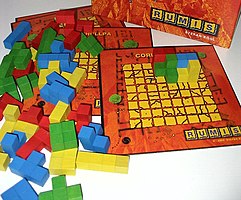Rumis
| Rumis | |
|---|---|
 Rumis: game components |
|
| Game data | |
| author | Stefan Kögl |
| publishing company | Murmel Spielwerkstatt and publishing house |
| Publishing year | 2003 |
| Art | Board game |
| Teammates | 2 to 4 |
| Duration | 15 to 20 minutes |
| Age | from 7 years |
Rumis , internationally known as Blokus 3D , is a strategy game by the game designer Stefan Kögl , who published it in 2003 for the Swiss game publisher Murmel Spielwerkstatt und Verlag . The game for two to four players, ages seven and up, takes about 20 minutes per round. The players have to build buildings together with three-dimensional building blocks and thus earn points.
Theme and equipment
The game is a strategy game in which the players have to build a building together with different building blocks and thus each gain points individually. In the original version of Rumis the author referred thematically to the “monumental buildings of the Inca ” and named the game in the subtitle “Stones of the Inca”, in later versions of Blokus 3D the concept is abstract.
In addition to the instructions, the content of the game box consists of four sets of 11 colored building blocks each, each composed of two, three or four cubes ( polyominos ), as well as four game boards that are used as a base for the building to be built.
Style of play
At the beginning of the game, each player chooses a player color and receives all the building blocks of this color. One of the game boards is selected, which determines the type and maximum height of the building. The latter also depends on the number of players. A wall (Pirka), a pyramid (Coricancha), a staircase (Pisac) or a tower (Chullpa) can be chosen as possible structures.
The game is played over several rounds in a clockwise direction. Beginning with a starting player, the players each place one of their building blocks within the area given on the game board. In the first round, the stones of all players must touch at least one area of one of the stones already lying on the floor as well as the base area, from the second round they must each touch at least one area of a stone of their own color. The stones must never be placed in such a way that they protrude above the surface or the boundaries set by the structure, and they must not form holes. If a player does not succeed in correctly placing a stone, he is eliminated from the game.
The game ends when no player can properly place stones. If this happens, a scoring takes place in which all stones visible from above each mean one point for the corresponding color. The winner is the player who scored the most points.
publication
The game Rumis was developed by the Swiss game designer Stefan Kögl and published in 2003 by the Swiss game publisher Murmel Spielwerkstatt und Verlag . In the same year it was included on the shortlist for Game of the Year . In addition, it was selected as one of five games at the Mensa Select Games of the American section of the Mensa International Association in 2004. After receiving the award, it was published by the American publisher Educational Insights, also under the name Rumis . From 2008 the game appeared with slightly changed rules as an abstract game Blokus 3D , based on the successful Blokus , by Winning Moves Games and later by Mattel . In 2008 Blokus 3D received a Japan Boardgame Prize and was nominated at the Boardgames Australia Awards .
At HUCH! a new version of the game was released in 2008 as Rumis + , also developed by Stefan Kögl.
supporting documents
- ↑ a b c d e Rumis , instructions for use, Murmel Spielwerkstatt und Verlag 2003
- ↑ a b c Versions of the game Rumis / Blokus 3D in the board game database BoardGameGeek ; accessed on March 31, 2020.
- ↑ Rumis on the website of the Spiel des Jahres eV; accessed on March 31, 2020.
- ↑ Mensa Select games on mensamindgames.com (selection 2004); accessed on March 31, 2020.
Web links
- Rumis in the Luding games database
- Rumis / Blokus 3D in the board game database BoardGameGeek (English)
- Rumis / Rumis + at Murmel Spielwerkstatt und Verlag